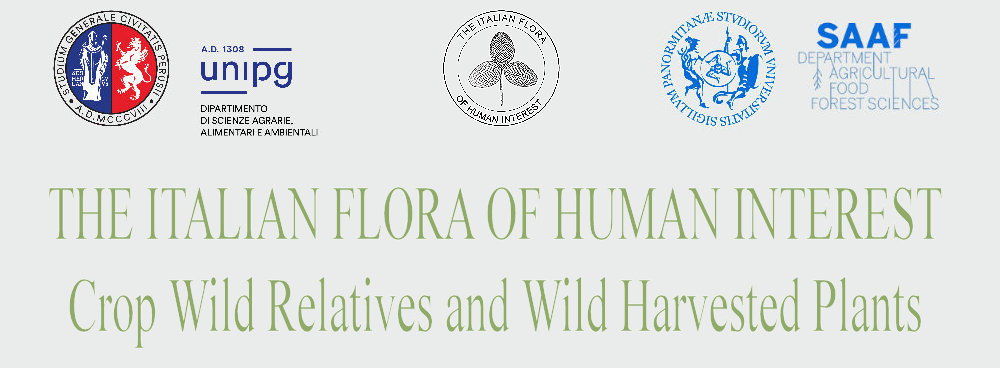
| Use classes adopted to define the economic importance of the taxa. The definitions follow the standards proposed by Wiersama & Leόn (1999). | |||||
| Use class | Explanation | ||||
| Food | This class includes plants consumed by humans as major crop constituents of food preparation, and clearly comprises the most important class economically. | ||||
| Drink | It includes plants used as constituent of beverage. In GRIN taxonomy are considered as Food subclass. | ||||
| Fodder | This class includes animal food: plant material harvested and fed to domestic animals and plant material upon which domestic animals feed themselves. | ||||
| Food additive | Taxa used as minor constituent of food preparations. | ||||
| Honey production | Plants important for honey production. | ||||
| Environmental | Many valuable economic plant are classified here including use for erosion control, soil improvement and agroforestry. | ||||
| Ornamental | This category includes taxa used by humans for their aesthetic or functional value within gardens or cities. In GRIN taxonomy are considered as a Environmental subclass. | ||||
| Material | This class includes a number of important economic plants, such as those which furnish fiber, timber, gums, resins and industrial or essential oil. | ||||
| Fuel | Category including the more traditional source of fuel, plants with potential to provide biomass for electricity generation are rapidly growing. | ||||
| Medicine | It includes plants that serve as source of specific pharmaceutical agents and those that are widely used. | ||||
| Folk medicine | It includes plants used as folklore remedies. In GRIN taxonomy are considered as a Medicine subclass. | ||||
| Poison | The economic impact of the poisonous plants classified here is largely negative. they are seldom traded commercially and have been treated only superficially. Nearly all plants recorded here are toxic to humans and livestock. | ||||
| Social | This minor use class includes few plants of widespread economic importance, although tobacco and those which provide illicit drugs are of considerable economic impact. | ||||
| Gene source | In addition to known or potential sources of beneficial genes for specific improvements in crop plants, numerous species can be successfully crossed with crop species to provide fertile progeny and thus must be considered important as genetic resource plants. A few species important as models for research in plant biology are included in this category. | ||||
| Ethnobotanical | This category includes plants that have ethnobotanical uses. | ||||
| Red List Categories | |||||
| ORSENIGO et al. 2020; ORSENIGO et al. 2018; ROSSI et al. 2016 | IUCN Red List of Threatened Species (version 3.1) | ||||
| RE | Regionally Extinct | EX | Extinct | ||
| CR(PE) | Critically Endangered (Possibly Extinct) | EW | Extinct in the Wild | ||
| CR | Critically Endangered | CR | Critically Endangered | ||
| EN | Endangered | EN | Endangered | ||
| VU | Vulnerable | VU | Vulnerable | ||
| NT | Near Threatened | NT | Near Threatened | ||
| LC | Least Concern | LC | Least Concern | ||
| DD | Data Deficient | DD | Data Deficient | ||
| NE | Not Evaluated | ||||
| Priority | |||||
| Code | Explanation | ||||
| A | The taxon is a relative to a crop with high value according with the ITPGRFA or ISTAT and it is considered priority for conservation because already included in at least one list of endangered taxa. The taxa in this category need of specific protection measures. | ||||
| B | The taxon is a relative to a crop with high value according with the ITPGRFA or ISTAT and it is considered priority for its endemicity restricted to whole of the Italian territory or only to a part of Italy. The taxa in this category not necessarily require specific protection measure but require monitoring because of their restricted distribution. | ||||
| C | The taxon is native and relative to a crop with high value according with the ITPGRFA or ISTAT. The taxon is neither included in any list of threatened taxa nor endemic. The taxa in this category do not need any specific protection measures. | ||||
| GP | Gene Pool, based upon the Harlan and de Wet gene pool concept (1971) | ||||
| GP1A | cultivated crop taxa. | ||||
| GP1B | (primary GP): wild or weedy forms of the crop that cross easily with assign each CWR to the appropriate sublevel based upon crossability data the crop. | ||||
| GP2 | (secondary GP): less closely related species from which gene transfer to the crop is possible but difficult using conventional breeding techniques. | ||||
| GP3 | (tertiary GP): species from which gene transfer to the crop is impossible, or if possible, requires sophisticated techniques, such as embryo rescue, somatic fusion or genetic engineering. |
||||
| TG | The taxon group concept employs taxonomic hierarchy as a proxy for taxon genetic relatedness and thus crossability (Maxted et al. 2006) | ||||
| TG1A | cultivated crop taxa | ||||
| TG1B | taxa within the same species as the crop | ||||
| TG2 | taxa within the same series or section as the crop | ||||
| TG3 | taxa within the same subgenus as the crop | ||||
| TG4 | taxa within the same genus as the crop | ||||
| TG5 | taxa within the same tribe as the crop | ||||



